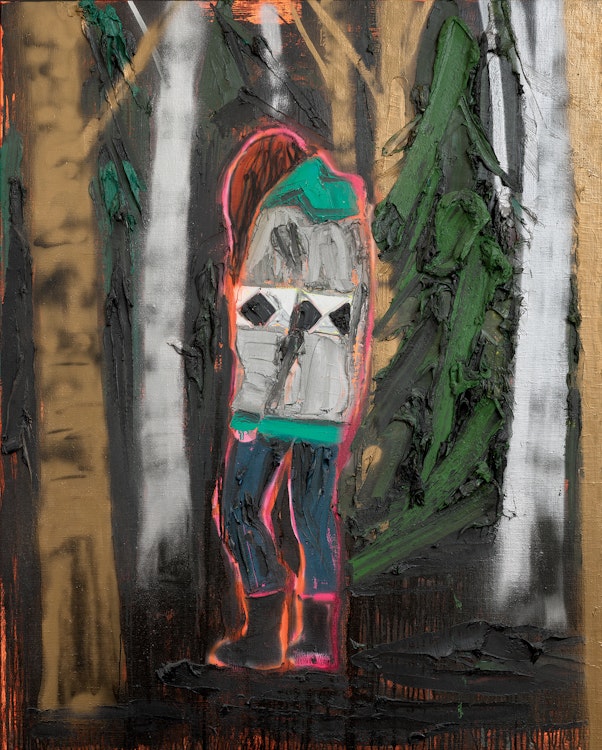Lost Mother #3 (2014) by Kim Dorland

Kim Dorland
Lost Mother #3 (2014)
oil and acrylic spray paint over linen over board
signed and titled on the right edge on the reverse
60 x 48 ins ( 152.4 x 121.9 cms )
Auction Estimate: $20,000.00 - $30,000.00
Price Realized $26,400.00
Sale date: December 1st 2022
Angell Gallery, Toronto
Private Collection, Toronto
Katerina Atanassova, ‘You are Here: Kim Dorland and the Return to Painting’ in Katerina Atanassova, Robert Enright and Jeffrey Spalding, “Kim Dorland”, Kleinburg, 2014, pages 6, 44, 46 and 56
Kim Dorland was inspired by artists such as Tom Thomson, Emily Carr, David Milne, and members of the Group of Seven–and their quest for bold, authentic, and expressive visual language. The artist goes so far as to credit the art of these painters with saving him, proclaiming: “Before I found art, I had no sense of the future. I could have ended up in a dead-end job or even jail, not because I was violent but because I was thoughtless. Then I found this. It was all I wanted.”
Unlike many of his contemporaries, Dorland made a conscious choice to work in the old traditions of oil painting, which was always a source of inspiration, as it was the medium of choice of Thomson, Carr, and all of his twentieth-century influences. However, Dorland formed his own personal approach–a uniquely multi-layered impasto, rendered with a vigour and density. “Lost Mother #3” presents the quintessential Dorland image of a solitary figure in a landscape, painted in his characteristic impasto application. A thin halo of neon orange and pink surrounds a figure walking away from the viewer, who wears a jacket, hoodie and rain boots. The forest is made up of gold and silver spray-painted tree trunks, contrasted by green pine branches in very thickly-applied pigment. Unlike the dazzling romantic landscapes of the Group of Seven, Dorland’s forests incite ambiguous feelings to the viewer: is it peaceful and familiar, or eerie and mysterious, or both? Curator Katerina Atanassova writes that “Nature is imbued with a psychological undertone that sets up an intense psychological dialogue between artist and viewers. In Dorland’s work, the forest often seems to be closing in on the artist, neither inviting nor foreboding, but pervaded by a feeling of intensity and danger.”
“Lost Mother #3” was completed in 2014, when Dorland’s two sons were ages eight and five years old. He had created other “Lost Mother” paintings in the preceding years. The mother figure was very relevant to him at this time, as he and his wife had recently become parents. While Dorland has depicted many figures who are alone in the woods, in this instance, “lost” could refer to the geographical sense of the word, as well as the emotional challenges of being a mother.
Dorland’s nature-inspired works are usually developed over an extended period of time, often involving field trips and Polaroid photo documentation, and sometimes drawn from remote and wild areas in his native Alberta. Dorland is not an “en plein air” artist, but prefers the comfort of his studio. Despite their large scale, Dorland’s forest landscapes lend themselves to a simple reduction of forms. Nature is stripped down to the bare essentials: line, shape, and colour. In “Lost Mother #3”, the forest is reduced to multiple vertical lines for tree trunks and branches, and a few textured masses for foliage. Atanassova also observes that Dorland does not typically identify a particular location for his landscapes; rather “Dorland’s world–although referencing locales in his native Wainwright, Alberta–is no longer focused on a specific place but rather represents a kind of ‘anywhere’.”
Share this item with your friends
Kim Dorland
(1974)
A native of Wainwright, Alberta, Dorland relies heavily on his tumultuous experiences growing up, translating into works that challenge preconceived notions of the Canadian wilderness. He studied at the Emily Carr Institute of Art and Design in Vancouver before earning his MFA at York University in Toronto in 2003. Dorland was also an artist-in-residence at the McMichael Canadian Art Collection in 2014.
With an emphasis on demystifying the idea of terra nullius—the void, pristine, virgin land often idealized by historical Canadian painting and art history—the artist often incorporates contemporary figures and objects in a rugged environment emphasizing one's place in the landscape. Dorland works in a variety of media, including neon pigments, spray paint and even inkjet technologies. Works often include hidden symbols and references to the relationship humans have on the landscape they inhabit. Graffiti, cars, toys and modern infrastructure populate Dorland’s landscapes, making a contemporary comment on the traditionally barren Canadian landscape throughout art history. In each work, strong formal elements of line, contrast, and colour figure prominently to create visually complex imagery. In doing this, the artist forms a dialogue with celebrated twentieth century Canadian painting technique rather than a rejection of tradition.
As one of Canada's leading contemporary painters, Dorland exhibits frequently in Canada from coast to coast at the institution and gallery level with regular art fair participation in Toronto and New York. His works are part of the collections of The Art Gallery of Alberta, Musée d’art contemporain de Montréal, Bank of Montréal, Royal Bank of Canada, and The Glenbow Museum among many other private and international collections.

